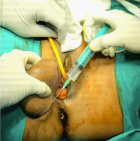Abstract
Research Article
Investigation of Stain Patterns from Diverse Blood Samples on Various Surfaces
Sonia Rajkumari*
Published: 12 August, 2024 | Volume 8 - Issue 1 | Pages: 028034
Bloodstain Pattern Analysis (BPA) is a crucial forensic technique in crime scene investigation, employing the interpretation of blood spatter patterns to reconstruct event sequences and determine spatial relationships between victims and surfaces. This study explores BPA’s application in forensic science, emphasizing its role in establishing links between crimes and culprits, as posited by Edmond Locard’s exchange principle. The research examines how bloodstain shape, size, and distribution reveal critical information about impact angles, areas of convergence, and points of origin, while also providing insights into blood flow direction, force applied, suspect positioning, and weapons used. The investigation delves into various bloodstain types, including void patterns, spikes, and satellite stains, and their formation on different surfaces. To enhance understanding of blood behaviour from various sources, the study compares blood samples from three species: human (Homo sapiens), obtained from a professional doctor from discarded piles with precaution from a government hospital in Laxmangarh, Rajasthan and goat (Capra aegagrus hircus), and chicken (Gallus gallus domesticus), obtained from butcher shops in Laxmangarh, Rajasthan. The experimental setup involves dropping blood from a height of 50 centimetre’s and measuring the resulting stain dimensions. This comprehensive approach to BPA research aims to refine crime scene analysis techniques, ultimately contributing to more accurate event reconstructions and enhanced forensic investigations. The study underscores the importance of BPA in modern forensic science while acknowledging the need for its integration with other investigative methods to ensure robust and reliable crime scene interpretations.
Read Full Article HTML DOI: 10.29328/journal.jfsr.1001061 Cite this Article Read Full Article PDF
Keywords:
Blood splatter analysis; Bloodstain pattern; Angle of impact; Velocity distance
References
- Pitrowski E. Über Entstehung Form, Direction and spread of traces of blood after slashing wounds to the head. Elmira Heights: Golos Printing. 1895; 8.
- Hulse Smith L, Mehdizadeh NZ, Chandra S. Deducing drop size and impact velocity from circular bloodstains. J Forensic Sci. 2005;50(1):54-63. Available from: https://pubmed.ncbi.nlm.nih.gov/15830997/
- Bevel T, Gardner RM. Bloodstain pattern analysis with an introduction to crime scene reconstruction. 2nd ed. Boca Raton: CRC Press; 2008. Available from: https://doi.org/10.1201/9781420052725
- James S, Kish P, Sutton T. Principles of bloodstain analysis. Boca Raton: CRC Press; 2005. Available from: https://doi.org/10.1201/9781420039467
- Peschel O, Kunz SN, Rothschild MA, Mutzel E. Bloodstain pattern analysis. Forensic Sci Med Pathol. 2011;7(3):257-270. Available from: https://doi.org/10.1007/s12024-010-9198-1
- Adrian W, Adrian L. Bloodstain pattern analysis. In: Fraser J, Williams R, editors. Handbook of forensic science. Devon: William Publishing; 2009; 229-231.
- Swgstain S. Scientific Working Group on Bloodstain Pattern Analysis. Recommended terminology. Forensic Sci Commun. 2009;11(2):1-7. Available from: http://theiai.org/docs/SWGSTAIN_Terminology.pdf
- Attinger D, Moore C, Donaldson A, Jafari A, Stone H. Fluid dynamics topics in bloodstain pattern analysis: Comparative review and research opportunities. Forensic Sci Int. 2013;231(1-3):375-396. Available from: https://doi.org/10.1016/j.forsciint.2013.04.018
- White B. Bloodstain patterns on fabrics: The effect of drop volume, dropping height and impact angle. J Can Soc Forensic Sci. 1986;19(1):3-36. Available from: https://doi.org/10.1080/00085030.1986.10757399
Figures:
Similar Articles
-
The Effect of Humidity on Blood Serum Pattern Formation and Blood TransferKelly P Kearse*. The Effect of Humidity on Blood Serum Pattern Formation and Blood Transfer. . 2023 doi: 10.29328/journal.jfsr.1001048; 7: 040-048.
Recently Viewed
-
Forensic Insights into Multiple Stab Wounds: Autopsy Findings from a Case of Sixty Stab WoundsAsif Hussain*. Forensic Insights into Multiple Stab Wounds: Autopsy Findings from a Case of Sixty Stab Wounds. J Forensic Sci Res. 2025: doi: 10.29328/journal.jfsr.1001075; 9: 021-024
-
Sinonasal Myxoma Extending into the Orbit in a 4-Year Old: A Case PresentationJulian A Purrinos*, Ramzi Younis. Sinonasal Myxoma Extending into the Orbit in a 4-Year Old: A Case Presentation. Arch Case Rep. 2024: doi: 10.29328/journal.acr.1001099; 8: 075-077
-
The relationship between IT consumption and anxiety in Pakistani youthWaqar Husain*,Sehrish Mobeen. The relationship between IT consumption and anxiety in Pakistani youth. Arch Psychiatr Ment Health. 2020: doi: 10.29328/journal.apmh.1001026; 4: 084-086
-
A Gecko-eye View of Naturalistic EnclosuresVictoria Davies, Abigail Heaman, James Brereton*. A Gecko-eye View of Naturalistic Enclosures. Insights Biol Med. 2023: doi: 10.29328/journal.ibm.1001026; 7: 013-019
-
Success, Survival and Prognostic Factors in Implant Prosthesis: Experimental StudyEpifania Ettore*, Pietrantonio Maria, Christian Nunziata, Ausiello Pietro. Success, Survival and Prognostic Factors in Implant Prosthesis: Experimental Study. J Oral Health Craniofac Sci. 2023: doi: 10.29328/journal.johcs.1001045; 8: 024-028
Most Viewed
-
Evaluation of Biostimulants Based on Recovered Protein Hydrolysates from Animal By-products as Plant Growth EnhancersH Pérez-Aguilar*, M Lacruz-Asaro, F Arán-Ais. Evaluation of Biostimulants Based on Recovered Protein Hydrolysates from Animal By-products as Plant Growth Enhancers. J Plant Sci Phytopathol. 2023 doi: 10.29328/journal.jpsp.1001104; 7: 042-047
-
Sinonasal Myxoma Extending into the Orbit in a 4-Year Old: A Case PresentationJulian A Purrinos*, Ramzi Younis. Sinonasal Myxoma Extending into the Orbit in a 4-Year Old: A Case Presentation. Arch Case Rep. 2024 doi: 10.29328/journal.acr.1001099; 8: 075-077
-
Feasibility study of magnetic sensing for detecting single-neuron action potentialsDenis Tonini,Kai Wu,Renata Saha,Jian-Ping Wang*. Feasibility study of magnetic sensing for detecting single-neuron action potentials. Ann Biomed Sci Eng. 2022 doi: 10.29328/journal.abse.1001018; 6: 019-029
-
Pediatric Dysgerminoma: Unveiling a Rare Ovarian TumorFaten Limaiem*, Khalil Saffar, Ahmed Halouani. Pediatric Dysgerminoma: Unveiling a Rare Ovarian Tumor. Arch Case Rep. 2024 doi: 10.29328/journal.acr.1001087; 8: 010-013
-
Physical activity can change the physiological and psychological circumstances during COVID-19 pandemic: A narrative reviewKhashayar Maroufi*. Physical activity can change the physiological and psychological circumstances during COVID-19 pandemic: A narrative review. J Sports Med Ther. 2021 doi: 10.29328/journal.jsmt.1001051; 6: 001-007

HSPI: We're glad you're here. Please click "create a new Query" if you are a new visitor to our website and need further information from us.
If you are already a member of our network and need to keep track of any developments regarding a question you have already submitted, click "take me to my Query."


















































































































































